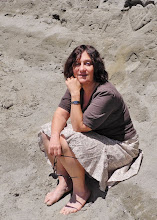 I've been busy observing Passover, the holiday which commemorates Israel's birth as a nation with an emphasis on reawakening or renewal, and catching up on my reading. Our holiday began with a wonderful Seder, in our home, among our dearest ones. There were many works of culinary art on our dining table, but the gefilte fish, made lovingly by David Waltman took center stage.
I've been busy observing Passover, the holiday which commemorates Israel's birth as a nation with an emphasis on reawakening or renewal, and catching up on my reading. Our holiday began with a wonderful Seder, in our home, among our dearest ones. There were many works of culinary art on our dining table, but the gefilte fish, made lovingly by David Waltman took center stage.Passover induces us to ask questions, and obliges each and every parent to teach the story of the Jews' Exodus from Egypt to their children, the goal being that we feel as if we're reliving the event. Jews all over the world meditate on what it means to be freed, released from enslavement. And enslavement comes in so many varieties, one of the worst being my tormentor; self-doubt.
So for the past days, I've been reading Elie Wiesel's latest book: A Mad Desire To Dance translated from the French by Catherine Termerson. Wiesel has always preferred questions to answers; it is the quest which intrigues him; he has a soft spot for madmen and visionaries. Wiesel writes in his memoirs: Aren't we all a little mad, each of us in his own way? Mad to wish to live and to refuse to live, mad to believe in the future and also to negate it, mad to think we have eluded death and the dead?
A Mad Desire To Dance is a tough read. The primary character, Dorial Waldman, a 60ish-year-old man, displaced in New York City, turns to Dr. Therese Goldschmidt, a Jewish psychotherapist, for help through his dark journey. Slowly, in disparate sequences and painful silences, he reveals his burdens. Waldman is a tormented soul; as a child he survived the Holocaust hiding in a barn with his father in Poland. His mother, passing for a gentile, worked for the Jewish Resistance. He lost his siblings to the Nazis, and his parents perished in a car accident right after the war, on the way to Palestine. Except for his Jewish Orthodox aunt and uncle in Brooklyn, Waldman is accompanied day and night by ghosts and images from the past, unable to decipher the spectral encounters from reality. While immersing himself in Jewish religious studies and undergoing spiritual wanderings, Waldman becomes convinced that he's possessed by a dybbuk. The telling of Dorial Waldman's tale to Dr. Goldschmidt is convoluted, devoid of chronological order, and may result in dizziness for the reader.
There are nuggets of Jewish mysticism and folklore sprinkled throughout this novel, making it well worth the struggle to piece together a cohesive narrative. Waldman shares this insight with his analyst:
In my tradition man is supposed to believe that Satan chooses as his favorite prey the just man, not the sinner. Satan is brave. And ambitious. Cunning. He deals with minor everyday sinners out of habit, between two yawns, almost without giving it a thought. He prefers to go where he isn't expected. Where the challenge means a struggle. Where victory, always uncertain, will create a sensation even in the loftiest spheres. Parenthetically, Doctor, do you believe in this theory?
Elie Wiesel has helped to guide me towards my own spiritual quest; perfect nourishment for Passover.
Photo by Talvi: gefilte fish, this time salmon

No comments:
Post a Comment